Carl Gustaf recoilless rifle
| Carl Gustaf Recoilless Rifle | |
|---|---|
|
A Carl Gustaf recoilless rifle of the Norwegian Army, on display in September 2010. | |
| Type | Multi-role (anti-armor, anti-fortification, anti-personnel, illumination) |
| Place of origin | Sweden |
| Service history | |
| In service | 1948–present |
| Used by | See Users |
| Wars |
Falklands War Kargil War War in Afghanistan Iraq War Eelam War IV Libyan Civil War Syrian civil war 2013 Lahad Datu standoff |
| Production history | |
| Designer | Hugo Abramson, Sigfrid Akselson and Harald Jentzen |
| Designed | |
| Manufacturer | Saab Bofors Dynamics (formerly Bofors Anti-Armour AB), Howa (license)[3][4] |
| Specifications | |
| Weight |
Rifle: 8.5 kg (19 lb) Mount: 0.8 kg (1.8 lb) |
| Length | Overall: 1.1 m (3 ft 7 in) |
| Crew | Two (gunner and loader), but may be used by a single operator at a reduced rate of fire. |
|
| |
| Cartridge | 84×246 mm R |
| Caliber | 84 mm (3.31 inches) |
| Rate of fire | 6 rounds per minute |
| Muzzle velocity | 230–255 m/s (750–840 ft/s) |
| Effective firing range |
|
| Feed system | Hinged breech |
| Sights | Open (iron) sights; optical 3×; laser rangefinder; image intensification system |
The Carl Gustaf (Swedish pronunciation: [ˈkʰɑːɭ ˈɡɵ̞stɑːv]; also known as, Gustaf Bazooka and M2CG) is an 84 mm man-portable reusable anti-tank recoilless rifle produced by Saab Bofors Dynamics (formerly Bofors Anti-Armour AB) in Sweden. Although most rounds fired by the Carl Gustaf work on the classic recoilless principle, modern rounds sometimes add a post-firing booster that technically make it a rocket launcher.
The first prototype of the Carl Gustaf was produced in 1946 as a lightweight anti-armor weapon, one of many similar designs of that era. While similar weapons have generally disappeared from service, the Carl Gustaf remains in widespread use today. A combination of light weight, low cost and widely varied ammunition types, makes the Carl Gustaf extremely flexible and able to be used in a wide variety of roles where single-purpose weapons like the M72 LAW passed out of service as newer tank designs rendered them ineffective.
In its country of origin it is officially named Grg m/48 (Granatgevär - "grenade rifle", model 48). British troops refer to it as the "Charlie G", while Canadian troops often refer to it as the "84" or "Carl G". In U.S. military service it is known as the "M3 Multi-Role Anti-Armor Anti-Personnel Weapon System" (MAAWS) or "Ranger Anti-tank Weapons System" (RAWS), but is often called the Gustaf or "the Goose" or simply the "Carl Johnson" by American servicemembers. In Australia it is irreverently known as "Charlie Gusto" or "Charlie Gutsache" (guts ache, slang for stomach pain).[5]
History
The Carl Gustaf was developed by Hugo Abramson and Harald Jentzen at the Kungliga Arméförvaltningens Tygavdelning ("Royal Swedish Arms Administration") and produced at Carl Gustaf Stads Gevärsfaktori from where it derives its name. The weapon was first introduced into Swedish service in 1948 as the 8,4 cm Granatgevär m/48 (Grg m/48), filling the same anti-tank role as the U.S. Army's bazooka, British PIAT and German Panzerschreck. Unlike these weapons, however, the Carl Gustaf used a rifled barrel for spin-stabilizing its rounds, as opposed to fins used by the other systems.
The use of the recoilless firing system allowed the Carl Gustaf to use ammunition containing considerably more propellant, firing its rounds at 290 m/s (950 ft/s), as opposed to about 105 m/s (340 ft/s) for the Panzerschreck and Bazooka and about 75 m/s (250 ft/s) for the PIAT. The result was superior accuracy at longer ranges. The Carl Gustaf can be used to attack larger stationary targets at up to 700 m (2,300 ft), but the relatively low speed of the projectile restricts attacks on moving targets to a range of 400 m (1,300 ft) or less.
The Carl Gustaf was soon sold around the world and became one of the primary squad-level anti-tank weapons for many West European armies. An improved version (M2) was introduced in 1964 and quickly replaced the original version. The current M3 version was introduced in 1991, using a thin steel liner containing the rifling, strengthened by a carbon fiber outer sleeve. External steel parts were replaced with aluminium alloys or plastics, reducing the empty weapon weight considerably—from 16.35 kg (36.0 lb) to 10 kg (22 lb).
In recent years, the weapon has found new life in a variety of roles. The British Special Air Service, United States Army Special Forces and United States Army Rangers use M3s in bunker-busting and anti-vehicle roles, while the German Bundeswehr maintains a small number of M2s for battlefield illumination. Many armies continue to use it as a viable anti-armor weapon, especially against 1950s- and 1960s-era tanks and other armored vehicles still in use worldwide.
In an incident during the Falklands War, Royal Marines defending Grytviken drove off an Argentinian corvette (the ARA Guerrico) with small arms fire, 66mm anti-tank rockets and their Carl Gustaf.[6]
The Carl Gustaf was used against Taliban defensive fortifications by soldiers of Princess Patricia's Canadian Light Infantry in operations in Afghanistan. They developed a new system for firing at night in which a spotter with a night-scope fires tracer ammunition to mark the target for the Carl Gustaf gunner.
Carl Gustaf launchers were used by Free Libyan Army during the Libyan Civil War in 2011; the weapons being used were either captured or provided by defecting members of the Libyan Army.
In November 2011, the U.S. Army began ordering the M3 MAAWS for regular units deployed in Afghanistan. Soldiers were being engaged with RPGs at 900 meters, while their light weapons had effective ranges of 500–600 meters. The Carl Gustaf allows airburst capability of troops in defilade out to 1,250 meters, and high explosive use out to 1,300 meters. While the weapon provides enhanced effectiveness, its 9.5 kg (21 lb) weight burdens troops. On 28 March 2013, USSOCOM announced a call for sources to develop a kit to lighten the M3 MAAWS and reduce overall length without affecting handling or ruggedness. By that time, Saab was developing a weight-reduced version prior to the SOCOM release that demonstrated no decrease in performance, no increase in recoil, and nearly equivalent barrel life that could be ready for government testing in 2014. Saab has also developed a new high explosive round that has a direct fire range of 1,500 meters when using a fire control system.[7]
At AUSA 2014, Saab Dynamics displayed its new Carl Gustaf M4 variant. Compared to the M3 MAAWS, the M4 is 3.4 kg (7.5 lb) lighter weighing 6.6 kg (15 lb) and shorter with a 950 mm (37 in) overall length. The shorter length was in response to the need to wield the weapon in urban terrain, and weight savings were achieved through using lighter components whenever possible including a carbon fiber tube with titanium liner, as well as a new venturi design. Other new features include a red-dot sight, a travel safety catch to allow the M4 to be carried while loaded, an adjustable shoulder rest and forward grip for improved ergonomics, a shot counter to keep track of how many rounds have been fired to manage the weapon's 1,000-round barrel life, picatinny rails for grips and sight mounts, and a remote round management function so intelligent sights can "talk" to programmable rounds.[8][9] The Defense Department agreed to evaluate the shorter and lighter M4 version over the next two years;[10] testing and qualifications are planned to be completed in spring 2017, and the weapon type classified as the M3A1 in fall 2017, making the system available for procurement to all Department of Defense services.[11]
Description
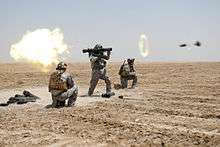

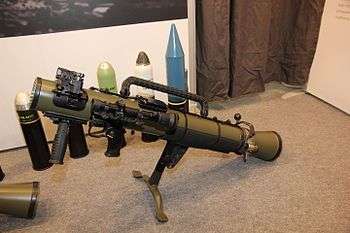
The basic weapon consists of the main tube with the breech-mounted Venturi recoil damper, with two grips near the front and a shoulder mount. The weapon is fitted with iron sights, but is normally aimed with the attached 3× optical sight with a 17 degree (300 mrad) field of view. The most modern variants fielded to Swedish rifle companies have been fitted with the Swedish Aimpoint sighting system. Luminous front and rear sight inserts are available for the iron sights when aiming at night, and an image intensification system may also be used.
The Carl Gustaf can be fired from the standing, kneeling, sitting or prone positions, and a bipod may be attached in front of the shoulder piece. An operating handle called the "Venturi lock" is used to move the hinged breech to one side for reloading. The weapon is normally operated by a two-man crew, one carrying and firing the weapon, the other carrying ammunition and reloading.
Specifications
- Calibre: 84 mm rifled (24 lands, progressive twist)[12]
- Crew: 2 optimal, 1 minimal
- Weights: 14.2 kg (M2); 8.5 kg (M3); 0.8 kg (mount); 7.0 kg (M4)
- Length: 1.13m (M2); 1.07m (M3); 1.0m (M4)
- Breech: Hinged
- Rate of fire: 6 rounds per minute
- Sights: Iron sights, optical 3×, laser rangefinder, image intensification system
M3 MAAWS
The M3 Multi-role Anti-armor Anti-tank Weapon System (MAAWS) is the U.S. military designation for the Carl Gustaf M3 recoilless rifle. It is primarily used by USSOCOM special operations forces (SOFs), such as the Army Rangers, Army Special Forces, Marine Raiders, Navy SEALs, JSOC operators, and other forces. When used by the U.S. Army's 75th Ranger Regiment, the M3 is known as the Ranger Anti-tank Weapons System (RAWS).
In the late 1980s, the Special Operations Forces Modernization Action Plan indicated need for a Ranger Anti-Armor/Anti-Personnel Weapon System (RAAWS) to replace the M67 recoilless rifle in use by the 75th Ranger Regiment. A market survey in 1987 indicated that the Carl Gustaf M3 was the best candidate for satisfying RAAWS requirements. On 29 September 1988, the M3 was selected as the RAAWS from candidate proposals submitted in response to the market survey compiled by ARDEC. A subsequent review of the contractor-supplied fatigue test data determined that the data did not meet U.S. Army requirements. Benét Laboratories conducted fatigue test of 2 tubes to establish an interim safe service life for the weapon. Tests were conducted in 1993. The manufacturer’s recommended life for the weapon was 500 rounds, but bore surfaces showed no indications of erosion until 2,360 rounds. The U.S. Navy SEALs became interested in the program and moved it to a Joint Integrated Product Team. The program name subsequently changed from the RAAWS to the Multi-Role Anti-Armor Anti-Personnel Weapon System (MAAWS).[13]
Army Rangers found the M3 Carl Gustaf was best employed using a two-man team. One person would carry the launcher and be armed with a pistol for personal protection, and the other would carry 5–6 rounds of ammunition and act as a spotter for the gunner. Although the single-shot AT-4 is lighter and can be carried by one person, a Gustaf team with the heavier recoilless rifle can reload and fire more rounds.[14]
The M3 MAAWS fires the following ammunition:
- High Explosive Dual Purpose (HEDP) round
- High Explosive Anti-Tank (HEAT) round
- High Explosive (HE) round
- Illumination round
- Smoke round
- Area Defence Munition (ADM) flechette round
In late 2012, the Army fielded 58 M3s and 1,500 rounds of ammunition to units deployed to Afghanistan to destroy enemy targets out to 1,000 meters. This was because RPG and machine gun teams could attack 900 meters away, while existing weaponry like the M141 Bunker Defeat Munition, M72 LAW, M136 AT-4 and MK153 SMAW had effective ranges of only 500 meters. The AT-4 is lighter and cheaper but is made of reinforced fiberglass, while the M3's rifled metal/carbon fiber launch tube allows for reloading. Employing the 22 lb M3 is easier than the 50 lb FGM-148 Javelin with its launcher with missile and reusable command launch unit, is faster than waiting on mortars, and is cheaper than the Javelin and artillery shells for engaging targets in hard cover.[13] Although Special Operations forces had been using the M3 since the early 1990s, light infantry unit commanders in Afghanistan had to submit operational needs statements to get the weapon. The M3 became an official program of record in the conventional Army in 2014, and a conditional materiel release was authorized in late 2015 to equip all brigade combat teams with one M3 launcher per platoon.[15]
Ammunition
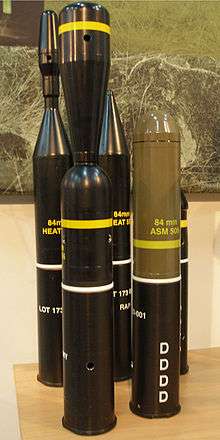
Improvements to the ammunition have been continual. While the older HEAT rounds are not particularly effective against modern tank armor, the weapon has found new life as a bunker-buster with an HEDP round. In addition, improved HEAT, high explosive (HE), smoke and illumination (star shell or flare) ammunition is also available. For full effectiveness, illumination rounds have to be fired at a very high angle, creating a danger for the gunner as the backblast from firing can burn him. For this reason, several armies have retired the illumination rounds, while the U.S. Army requires that they be fired from a standing position.
Note that the following are Canadian designations (other countries use similar terminology, replacing the "FFV")
- FFV441 is an HE round, useful in a "lobbed" trajectory to 1,000m, which can be fused to either detonate on impact or as an airburst.
- FFV441B is an HE round with an effective range against personnel in the open of 1,100 m. The round arms after 20 to 70 m of flight, weighs 3.1 kg, and is fired at a muzzle velocity of 255 m/s.[12]
- FFV469 is a smoke round fired like the FFV441, with a range of about 1,300 m. The 3.1 kg round is also fired at 255 m/s.[12]
- FFV502 is an HEDP round with the ability to be set to detonate on either impact or one-tenth of a second afterwards. Effective range is 1,000 m against dispersed soft targets such as infantry in the open, 500 m against stationary targets and 300 m against moving targets. Minimum range is 15 to 40 m to arm the warhead. Penetration exceeds 150 mm of rolled homogeneous armour (RHA). Ammunition weight is 3.3 kg and muzzle velocity is 230 m/s.[12]
- FFV545 is an illuminating star shell, fired up to 2,300 m maximum range, but with an effective envelope of 300 to 2,100 m. Suspended by parachute, the star shell burns for 30 seconds while producing 650,000 candela, providing a 400 to 500 m diameter area of illumination.
- FFV551 is the primary HEAT round and is a rocket-assisted projectile (RAP). Effective range is up to 700 m (400 m against moving targets) and penetration up to 400 mm of RHA. Ammunition weight is 3.2 kg and muzzle velocity is 255 m/s.[12]
- FFV552 is a practice round with the same ballistics as the 551.
- FFV651 is a newer HEAT round using mid-flight rocket assistance for ranges up to 1,000m. In theory, it has less penetration than the FFV551, but it includes a stand-off probe for the fuse to improve performance against reactive armour.
- FFV751 is a tandem-warhead HEAT round with an effective range of 500 m and ability to penetrate more than 500 mm of armour. Weight is 4 kg.[12]
- HEAT 655 CS (Confined Spaces) "high-explosive anti-tank (HEAT) round that can be fired by the 84 mm Carl Gustaf recoilless weapon from within small enclosures"[16]
Users
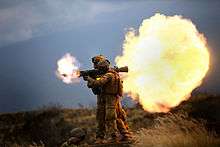
-
 Austria[17]
Austria[17] -
 Bangladesh
Bangladesh -
.svg.png) Belgium[19]
Belgium[19] -
 Belize[17]
Belize[17] -
 Botswana[17]
Botswana[17] -
 Brazil[17]
Brazil[17] -
 Burkina Faso[17]
Burkina Faso[17] -
 Burma[20]
Burma[20] -
 Canada[17]
Canada[17] -
 Czech Republic[21]
Czech Republic[21] -
 Denmark:[17] M2 called M/79,[22] M3 called M/85.[23] Commonly referred to as "Dysekanon" in the army.
Denmark:[17] M2 called M/79,[22] M3 called M/85.[23] Commonly referred to as "Dysekanon" in the army. -
 Estonia: M2, M3.[24]
Estonia: M2, M3.[24] -
 Germany[19]
Germany[19] -
 Ghana[17]
Ghana[17] -
 Greece[25]
Greece[25] -
 Honduras[17]
Honduras[17] -
 India:[17] a modified version has also been developed by the DRDO which is significantly lighter due to use of advanced composites.[26]
India:[17] a modified version has also been developed by the DRDO which is significantly lighter due to use of advanced composites.[26] -
 Indonesia: used by the Komando Pasukan Katak (Kopaska) tactical diver group and Komando Pasukan Khusus (Kopassus) special forces group.[27]
Indonesia: used by the Komando Pasukan Katak (Kopaska) tactical diver group and Komando Pasukan Khusus (Kopassus) special forces group.[27] -
 Ireland: Defence Forces specialist units, including Army Ranger Wing (ARW).[17]
Ireland: Defence Forces specialist units, including Army Ranger Wing (ARW).[17] -
 Israel[17]
Israel[17]
-
 Japan: M2 called 84 mm Recoilless Rifle.,[4] M3 called multi-purpose gun (多用途ガン)'
Japan: M2 called 84 mm Recoilless Rifle.,[4] M3 called multi-purpose gun (多用途ガン)' -
 Kenya[17]
Kenya[17] -
 Kuwait.[28]
Kuwait.[28]  Latvia: M2, M3.
Latvia: M2, M3. Libya[17]
Libya[17] Lithuania: M2, M3.[29][30]
Lithuania: M2, M3.[29][30]-
 Malaysia[17]
Malaysia[17] -
 Myanmar: used by divisional heavy weapon companies in bunker busting/infantry support/light artillery role for counter-insurgency campaigns.
Myanmar: used by divisional heavy weapon companies in bunker busting/infantry support/light artillery role for counter-insurgency campaigns. -
 New Zealand[17]
New Zealand[17] -
 Nigeria[17]
Nigeria[17] -
 Norway[17]
Norway[17] -
 Pakistan[31]
Pakistan[31] -
 Poland: used by special forces.[32]
Poland: used by special forces.[32] -
 Portugal[33][34]
Portugal[33][34] -
 Sierra Leone[17]
Sierra Leone[17] -
 Slovakia: Launch customer for the M4 variant.[35]
Slovakia: Launch customer for the M4 variant.[35]
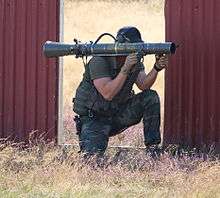
-
 Sweden[17]
Sweden[17] -
 Tamil Eelam: used by the Tamil Tigers during the Final Eelam War.[36]
Tamil Eelam: used by the Tamil Tigers during the Final Eelam War.[36] -
 Thailand[17]
Thailand[17] -
 United Arab Emirates[17]
United Arab Emirates[17] -
 United Kingdom: M2 variant was used from the 1970s until the early 1990s.[37] AEI Systems Ltd. – a British defence products manufacturer headquartered in Ascot, Berkshire – offers a variant of the platform dubbed the AE84-RCL designed to fire the M540/M550 line of 84×246 mm R ammunition manufactured in Belgium by Mecar.[38]
United Kingdom: M2 variant was used from the 1970s until the early 1990s.[37] AEI Systems Ltd. – a British defence products manufacturer headquartered in Ascot, Berkshire – offers a variant of the platform dubbed the AE84-RCL designed to fire the M540/M550 line of 84×246 mm R ammunition manufactured in Belgium by Mecar.[38]
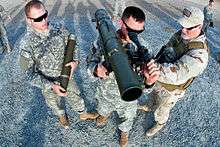
-
 United States: used by USSOCOM, U.S. Army Ranger battalions,[39] and some regular U.S. Army infantry units in the War in Afghanistan.[40][41] In February 2014, the M3 MAAWS was designated as a Program of Record within the U.S. Army and became standard-issue in Army Light Infantry units.[42][43]
United States: used by USSOCOM, U.S. Army Ranger battalions,[39] and some regular U.S. Army infantry units in the War in Afghanistan.[40][41] In February 2014, the M3 MAAWS was designated as a Program of Record within the U.S. Army and became standard-issue in Army Light Infantry units.[42][43] -
 Venezuela
Venezuela -
 Zambia[17]
Zambia[17]
Former users
See also
- NIVA XM1970, early 1970s attempt to produce a lower cost alternative to the M2 version of the Grg m/48 then in Swedish Army service
- Panzerfaust 3 (German, 1992, man-portable)
- AT4, a Swedish one-shot rocket/recoilless-rifle assault weapon
- SMAW, an American 83 mm rocket assault weapon
- M72 LAW, an American 66 mm light anti-tank weapon
- RPG-2 (USSR, 1947, man-portable)
- 55 S 55 (Finland, 1947, 55 mm, man-portable)
- M40 recoilless rifle (USA, 1947, 105 mm, tripod mounted)
- B-10 recoilless rifle (USSR, 1954, 82 mm, tripod mounted)
- M67 recoilless rifle (USA, 1960s, 90 mm, man-portable)
References
- ↑ Carl Gustaf M4, Saab, 2014
- ↑ Saab’s latest Carl Gustaf M4 system impresses customers in live fire demonstration (press release), Saab, 2014-09-26,
The official Carl Gustaf M4 product launch will take place at the AUSA exhibition in Washington, DC, on 13–15 Oct 2014
- ↑ "84mm無反動砲「カール・グスタフ」", Right-Wing (in Japanese), JP: Sakura, retrieved 2009-11-04
- 1 2 Exhibition of Equipments, JP: Plala, retrieved July 29, 2008.
- ↑ "The Encyclopedia of Middle East Wars", p. 259
- ↑ "The Falklands Conflict – The Defence of Grytviken", Navy News, UK, 2002, archived from the original on 2003-05-07.
- ↑ "SOCOM Seeks Lighter Carl Gustaf". Defense media network. 22 April 2013..
- ↑ New Carl-Gustaf weapon system design unveiled – Military1.com, 8 October 2014
- ↑ Saab Adds Capabilities In New Recoilless Rifle Aviation Week, 13 October 2014
- ↑ Army, Special Operations Forces Eye Lighter, Cheaper Shoulder-Fired Weapons National Defense Magazine, 10 November 2014
- ↑ Army Evaluates New Shoulder-Fired Rocket Tech - Kitup.Military.com, 20 October 2016
- 1 2 3 4 5 6 OPFOR Worldwide Equipment Guide, U.S.: Army TRADOC DCSINT Threat Support Directorate, January 1999.
- 1 2 "Saab to Supply Carl-Gustaf 84mm Recoilless Rifle System to the U.S. Army", SA defense journal, 19 June 2013.
- ↑ Carl Gustaf Rules In America, Strategy page, 10 September 2014.
- ↑ US Army Adds 84mm Recoilless Rifle to Platoon Arsenal - Military.com, 20 May 2016
- ↑ "Saab reveals confined spaces capability for Carl Gustaf", Infantry Weapons, Jane's.
- 1 2 3 4 5 6 7 8 9 10 11 12 13 14 15 16 17 18 19 20 21 22 23 24 Jones, Richard D. Infantry Weapons 2009/2010. Jane's; 35 ed. (January 27, 2009). ISBN 978-0-7106-2869-5.
- ↑ "Direct fire support weapons land 40 phase 2". Defence Material Organisation. October 2010. Archived from the original on 10 April 2011. Retrieved 24 April 2011.
- 1 2 "Grenade", World, RU: Guns.
- ↑ "Svenska vapen hos Burmas arme" [Sweden sells to Burma’s army], SvD (in Swedish), SE.
- ↑ Karl Gustaf protitanková zbraň (in Czech), CZ: Army.
- ↑ "Dysekanon M/79", Panser værns våben (in Danish), DK: Dansk panser.
- ↑ "Dysekanon M/85", Panser værns våben (in Danish), DK: Dansk panser.
- ↑ http://www.mil.ee/et/kaitsevagi/tehnika/relvad/carl-gustav-m2
|contribution-url=missing title (help), Tehnika [Technical] (in Ewe), EE: Military. - ↑ "Armored vehicle weapons in formation", Greek Army ground forces military equipment, Army Recognition.
- ↑ "DRDO Develops New 84mm Lightweight Anti-Tank System". India.
- ↑ "Kopassus & Kopaska – Specijalne Postrojbe Republike Indonezije" (in Croatian). HR: Hrvatski Vojnik Magazine. Archived from the original on 2010-08-22. Retrieved 2010-06-12.
- ↑ Kuwait – Army Equipment, Global security.
- ↑ Prieštankinis granatsvaidis AT-4 (in Lithuanian), LT: KAM.
- ↑ Prieštankinis granatsvaidis "Carl Gustaf" M2, M3 (in Lithuanian), LT: KAM.
- ↑ "Pakistan Army". PK: Defence. Archived from the original on 2013-10-12.
- ↑ Altair, PL.
- ↑ Exercício Capolo no distrito de Santarém [Capolo exercise in the Santarém district] (in Portuguese), PT: Operacional.
- ↑ "Armas", Meios dos fuzileiros [Marines’ equipment] (in Portuguese), PT: Marinha.
- ↑ Launch customer for Carl-Gustaf M4 - Shephardmedia.com, 16 September 2015
- ↑ Army, LK, archived from the original on 2011-12-17.
- ↑ Owen, William F. (2007). "Light Anti-Armour Weapons: Anti-Everything?" (PDF). Asian Military Review. Archived from the original (PDF) on 2011-07-07. Retrieved 2010-05-12.
- ↑ AE84-RCL recoilless rifle, AEI Systems, retrieved September 16, 2014.
- ↑ The World defense almanac 1996–97, p. 32.
- ↑ Robinson, Spc Nigel (2011-10-27). "Carl Gustaf Recoilless Rifle". 7th Mobile Public Affairs Detachment. Defense Video and Imagery Distribution System. Retrieved 15 November 2011.
- ↑ "U.S. Army Orders Additional Carl-Gustaf Weapon System", Defense talk, 27 September 2012.
- ↑ "Carl Gustaf Selected as Standard Equipment for U.S. Army Light Infantry Units", Deagel, 20 February 2014.
- ↑ "US Army approves Carl Gustaf M3 MAAWS for general use", IHS Janes, 16 May 2016.
- ↑ "Army News - Issue No. 235" (PDF). Ministry of Defence, Singapore. 2015. Archived from the original (PDF) on 2015-06-23. Retrieved 2015-06-23.
External links
| Wikimedia Commons has media related to Carl Gustaf. |
- Saabs Bofors – manufacturer's product page
- Saab Bofors – official manufacturer's brochure
- Saabs Bofors – Area Defence Munition (ADM 401) brochure
- Instructors Manual – Canadian Forces
- Video of loading and firing drill for Carl Gustaf recoilless rifle
- Video of a Carl Gustaf recoilless rifle being fired
- M3 MAAWS at GlobalSecurity.org
- Carl Gustaf anti-tank recoilless rifle (Sweden) – Modern Firearms
- U.S. Army Armament Research, Development & Engineering Center FCT and SOCOM Shoulder Fired Weapons May 2005

_soldier%2C_right%2C_participates_in_a_simulated_combined_company_attack_with_U.S._Marines_assigned_to_the_1st_Battalion%2C_1st_Marine_Regiment_at_Marine_Corps_Base_Camp_140209-M-SV584-216.jpg)